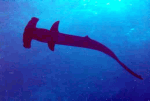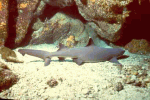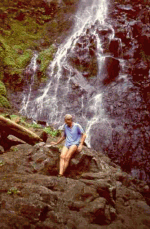by Mary L. Peachin with photography by Jay Ireland and Mary L. Peachin
Apr 2000, Vol. 4 No. 7
 “You’ll want to be my dive buddy this week. Trust me on this.” The young man looked at me, quizzically, wondering why a smiley silver-haired lady would make such a definitive comment. Benji, young enough to be my son, was unaware that during the Okeanos Aggressor’s routine checkout dive, while the diving crew assessed our underwater capabilities, I was busy evaluating the divers. When diving with sharks, “babysitting” an anxious buddy reduces both the time spent at depth with scalloped hammerheads, and the opportunity for an up-close experience.
“You’ll want to be my dive buddy this week. Trust me on this.” The young man looked at me, quizzically, wondering why a smiley silver-haired lady would make such a definitive comment. Benji, young enough to be my son, was unaware that during the Okeanos Aggressor’s routine checkout dive, while the diving crew assessed our underwater capabilities, I was busy evaluating the divers. When diving with sharks, “babysitting” an anxious buddy reduces both the time spent at depth with scalloped hammerheads, and the opportunity for an up-close experience.
Twelve of us were willing to tolerate the excruciating 42-hour boat ride to the Cocos Islands, 300 miles south of Costa Rica, just to dive with the “big stuff”—schooling hammerhead sharks, white-tip and oceanic reef sharks, pilot whales, whale sharks, sailfish and marlin, manta and eagle rays, wahoo, and tuna.
 Contrary to their maligned reputation, the hammerheads—Cocos’ primary attraction—are shy, elusive sharks that swim off at the sight or sound of a diver’s bubbles. The normal water temperature of 70-72 degrees had been warmed by an El Niño current to about 82 degrees. My twenty years of experience reinforced my hunch that only the first divers down to depth (and on this trip depth could be 150 feet) would be lucky enough to see the hammerheads. I was looking for a buddy who could backroll from a Zodiac raft and descend quickly to depth. Benji was my man, he just didn’t know why.
Contrary to their maligned reputation, the hammerheads—Cocos’ primary attraction—are shy, elusive sharks that swim off at the sight or sound of a diver’s bubbles. The normal water temperature of 70-72 degrees had been warmed by an El Niño current to about 82 degrees. My twenty years of experience reinforced my hunch that only the first divers down to depth (and on this trip depth could be 150 feet) would be lucky enough to see the hammerheads. I was looking for a buddy who could backroll from a Zodiac raft and descend quickly to depth. Benji was my man, he just didn’t know why.
The crew of our mothership (Okeanos Aggressor, a 120′ converted fish trawler) divided twelve of us into two Zodiacs. Benji must have trusted me because he switched his gear into my assigned zodiac.
 We entered the water and descended. This was open-water diving, no shark cages for protection. We had to navigate through strong, shifting currents; always aware of riptide-like surges that could smash us against boulders covered with long-spined sea urchins. We could spend only minutes at depth looking for sharks before ascending for decompression limits to explore the crevices of the boulders for lobsters, stingray, octopus and other sea “critters.” Benji’s decision to be my buddy was rewarded on the first dive of the weeklong trip—we were the only divers to see hammerheads. We also saw some interesting “critters,” the most unusual being the camouflaged orange frogfish. When it was time to ascend, we drifted away from the boulders, once again searching the deep blue water for any glimpse of the “big stuff.”
We entered the water and descended. This was open-water diving, no shark cages for protection. We had to navigate through strong, shifting currents; always aware of riptide-like surges that could smash us against boulders covered with long-spined sea urchins. We could spend only minutes at depth looking for sharks before ascending for decompression limits to explore the crevices of the boulders for lobsters, stingray, octopus and other sea “critters.” Benji’s decision to be my buddy was rewarded on the first dive of the weeklong trip—we were the only divers to see hammerheads. We also saw some interesting “critters,” the most unusual being the camouflaged orange frogfish. When it was time to ascend, we drifted away from the boulders, once again searching the deep blue water for any glimpse of the “big stuff.”
The islands teem with a variety of other life, as well. Scientists have identified 97 species of birds, two endemic species of reptiles, 57 crustaceans, 500 mollusks, 800 species of insects, turtles including black, olive and Indo-Pacific hawksbill, and five species of freshwater fish. While eager to see observe the islands’ 300 species of saltwater fish, we were focused on hammerhead sharks.
There are less than half a dozen dive sites surrounding the Cocos; most are underwater seamounts with names like Dirty Rock or Submerged Rock. Sharkfin rises above the water in a shape resembling its name. The dive boat usually anchors in the calmer waters of Manuelita Bay.
 Our divemaster, Jay, shared a number of diving precautions. When diving in surging water, he suggested, carefully observe the fish: “When they swim, you swim. They’re used to the currents of the surge.” Underwater currents in the Cocos can be either horizontal (side to side) or vertical (up and down), sometimes sweeping divers 10 to 20 feet in any direction. Jay also cautioned about bracing against seamount boulders to avoid hitting them. “The boulders are covered with urchins and barnacles,” he explained; “their spines do not feel good in your body. Currents change continually, and with visibility limited to 50 or 75 feet, Zodiac drivers can’t follow your air bubbles. Be very careful when you surface, to avoid being run over by a inflatable boat.” His warnings illustrated a few additional reasons that Cocos is a destination for experienced divers.
Our divemaster, Jay, shared a number of diving precautions. When diving in surging water, he suggested, carefully observe the fish: “When they swim, you swim. They’re used to the currents of the surge.” Underwater currents in the Cocos can be either horizontal (side to side) or vertical (up and down), sometimes sweeping divers 10 to 20 feet in any direction. Jay also cautioned about bracing against seamount boulders to avoid hitting them. “The boulders are covered with urchins and barnacles,” he explained; “their spines do not feel good in your body. Currents change continually, and with visibility limited to 50 or 75 feet, Zodiac drivers can’t follow your air bubbles. Be very careful when you surface, to avoid being run over by a inflatable boat.” His warnings illustrated a few additional reasons that Cocos is a destination for experienced divers.
Midway through the week, in addition to the hammerheads, we had seen dozens of white-tip sharks, the larger, more aggressive oceanic shark, marble and eagle rays, yellowfin tuna, jack crevalle, and turtles.
 A particular thrill was diving in the midst of a pod of pilot whales. Although we’d sighted them from the boat, being underwater and hearing the dolphin-size whales “sing” was a rare experience. Several divers saw a school of yellowfin tuna precede the whales. Two other divers were ecstatic to glimpse a sailfish, fin majestically unfurled.
A particular thrill was diving in the midst of a pod of pilot whales. Although we’d sighted them from the boat, being underwater and hearing the dolphin-size whales “sing” was a rare experience. Several divers saw a school of yellowfin tuna precede the whales. Two other divers were ecstatic to glimpse a sailfish, fin majestically unfurled.
During the week, we took a couple of breaks between dives to explore the island. The rugged coral-based rainforest, two miles wide by four long, rises 500 feet above the ocean. Waterfalls, some plunging directly from cliffs into the sea, are evidence of the large of amount of yearly rainfall. The endemic cupey palm and the huriki, with its spreading crown, dominate the dense forest. In 1978, the island and its surrounding waters area were declared a nature preserve by the government of Costa Rica.
 Legends of hidden pirate treasure in the Cocos Islands go back to the 1600s, but credit for the chain’s discovery is given to a British whaler named Captain Belcher. When his ship departed the island in 1838, Belcher left behind a few pigs, which flourished, today numbering near 5,000. The rooting habits of the pigs, however, creates erosion; silt runoff kills living coral around the island.
Legends of hidden pirate treasure in the Cocos Islands go back to the 1600s, but credit for the chain’s discovery is given to a British whaler named Captain Belcher. When his ship departed the island in 1838, Belcher left behind a few pigs, which flourished, today numbering near 5,000. The rooting habits of the pigs, however, creates erosion; silt runoff kills living coral around the island.
Two park rangers in one small Zodiac patrol the islands, under order to shoot the pigs and report any shark fishermen violating the three-mile fishing zone. However, eliminating the pigs is impossible, as is regulating illegal shark fishing. The terrain is steep and barricaded by dense vegetation. Dozens of fisherman, shark fins drying on lines, sleep during the daytime on rickety boats that do not appear seaworthy enough to make the long crossing from Costa Rica.
 One hike took us to a two hundred-foot waterfall near Wafer Bay. After riding in the Zodiac from the Okeanos to just beyond the breaking waves, we jumped into the ocean and bodysurfed onto the crab-covered rocky beach. Before a rugged half-mile climb through the rainforest, we were cautioned about using potentially poisonous roots or vines for handholds, or stepping on logs, which might be rotted. Hot and sweaty upon reaching our destination, we jumped into the refreshingly cool pool at the base of the waterfall, sharing our swim with some of its inhabitants, freshwater shrimp. At a second island location, the beach entry was easier because the tide was low and the beach sandy. Large boulders strewn around the beach have names carved into them, including that of legendary diver Jacque Cousteau. The oldest “graffiti” we saw was dated 1880. We hiked up a creek, climbing over rocks that diverted the stream. But time was limited and we were at Cocos to dive.
One hike took us to a two hundred-foot waterfall near Wafer Bay. After riding in the Zodiac from the Okeanos to just beyond the breaking waves, we jumped into the ocean and bodysurfed onto the crab-covered rocky beach. Before a rugged half-mile climb through the rainforest, we were cautioned about using potentially poisonous roots or vines for handholds, or stepping on logs, which might be rotted. Hot and sweaty upon reaching our destination, we jumped into the refreshingly cool pool at the base of the waterfall, sharing our swim with some of its inhabitants, freshwater shrimp. At a second island location, the beach entry was easier because the tide was low and the beach sandy. Large boulders strewn around the beach have names carved into them, including that of legendary diver Jacque Cousteau. The oldest “graffiti” we saw was dated 1880. We hiked up a creek, climbing over rocks that diverted the stream. But time was limited and we were at Cocos to dive.
At the end of one diving day, several of us took the Zodiac out to fish for our dinner. We circled the island, using a monofilament handline to catch a 35-pound wahoo and a smaller jack crevalle. The evening ended with a pod of pilot whales circling us in the setting sun.
If you go:
Best time to travel: The ocean temperature is warmer (74-82 degrees) during the dry season of November to May, but the diving is reputed to be better in the wet and “misty” season of June, July, and August. During summer months, whale sharks migrate through the islands and hammerheads school in shallower water
Transportation: American Airlines provides non-stop service (an approximate 3-hour flight) between Miami or Dallas to the capitol city of San Jose, Costa Rica.
Accommodations: Since divers are required to arrive the day prior to departure, accommodations are necessary in San Jose. There are many destination resorts in San Jose, but two smaller, more charming properties are: Hotel Grano de Oro, Calle 30 between Ave. 2 & 4, e-mail [email protected] or fax 011-506-221-2782 Barcelo Amon Plaza Avenida 11 & Calle 3, e-mail [email protected] or fax 011-506-257-00284
Boat Departure: The Okeanos Aggressor departs from the port of Puntarenas, a two-hour drive to the West Coast. The Aggressor Fleet provides van transportation both ways. A C-card or proof of dive certification is required to board the ship. This trip is recommended only for experienced divers.
Park Fee, Dive Tax and Departure tax: The Costa Rican government requires a $105 U.S cash only conservation fee to dive the Cocos Islands. There is also a $28.00 U.S. dive tax. Costa Rica has a $17.00 departure tax.
